In the narrow strait between India and Sri Lanka, fishermen are locked in a deadly battle over dwindling catches.
RAMESWARAM, India—
Victos Fernando had been missing for four days when his body washed up, bruised and salt-soaked, off Sri Lanka’s northern coast. He’d disembarked with three other fishermen on April 2, 2011, from the crowded harbor of Rameswaram, a small island off India’s southeastern coast, to sail for the fertile breeding shoals on the Sri Lankan side of the Palk Strait, the narrow body of water that separates the two nations. The day before, the governments of India and Sri Lanka had both issued warnings against going out to sea. The two countries were slated to play a cricket match that day and tensions would be high.
Someone, after all, would have to lose.
The post-mortem on Fernando’s body showed heavy bruising on the arms, legs, and chest. Within 10 days, the three bodies of Fernando’s crewmates had come ashore on their native soil in the Indian state of Tamil Nadu. According to a fisherman named U. Arulanandam, a local activist with the Alliance for the Release of Innocent Fishermen, doctors reported broken teeth and abrasions left by razor blades inserted under the victims’ toenails. Sri Lanka had lost the match; the Indian fishermen had been tortured and tossed like refuse into the sea.
“There’s always some reason. That day it was cricket, some other day it’s some other tension,” Chenatam Fernando, Victos Fernando’s younger brother, told me. “Fishing is dangerous.”
Tensions have been high on the strait since 1983, when Sri Lanka first descended into a three-decade-long civil war that pitted its Sinhalese majority in the south against the Tamil minority in the north. Indian Tamil fishermen, who come from the same ethnic stock as their counterparts in Sri Lanka, started crossing the maritime border regularly to fish and to smuggle goods—everything from spare radio parts to firearms—to their brethren across the water. Hundreds of thousands of Sri Lankan Tamil refugees fled in the opposite direction, many of them making landfall in Rameswaram. The Sinhalese navy saw every Indian vessel as a potential threat and took to assaulting and killing Indian fishermen more or less at will. In 30 years, they racked up a body count of some 300 fishermen, with countless others suffering injuries and financial losses at their hands.
They’re like pirates, thieving everything.
The war ended in 2009 and the killings stopped following Fernando’s death in 2011, but many families are still reeling emotionally and financially from losses suffered during decades of violence, with ongoing government assistance doing little to ameliorate their problems. And even now, weekly reports surface of Indian fishermen being detained, assaulted, and having their equipment confiscated by the Sri Lankan navy. “They’re like pirates, thieving everything,” Chenatam Fernando says of the Sri Lankan navy. “The nets, the fish, even the rice.”
In Rameswaram, fishermen like Chenatam Fernando see themselves as hapless victims of an interminable border war. To the Sri Lankans, they’re little better than thieves. I said as much to Fernando, but he dismissed the notion with a sad shake of the head. “The same waters we’ve been fishing for 1,000 years. We’re all Tamilans,” he said. “Where the fish go, we follow. If the fish run, we also run.”
Compared with India’s fractious land borders, which trace some of the world’s most active geopolitical fault lines, the Palk Strait looks calm, a seemingly clear-cut border between two young nations on two separate landmasses. At its narrowest point, 18 miles of open water separate the Indian island of Rameswaram, a stiletto thrust eastward into the strait, from the Sri Lankan island of Mannar. Between them lies a barely submerged series of shoals known as the Ram Sethu (or Ram’s Bridge), built, as the great Hindu epic the Ramayana tells us, by an army of ape-men so that the God Rama could invade the kingdom of Lanka and rescue his wife, Sita, from a 10-headed demon king.
As the number of boats on the strait increases, there are fewer and fewer fish left to follow. The Palk Strait, once a place of limitless abundance, has become the focal point of a conflict no longer fought over religion or arms or the kidnapped wife of a god, but over fish.

As recently as the 1970s, the divide between the Tamils of Mannar and Rameswaram was, at best, notional. Families would marry across the strait and cross back and forth on holidays, gathering each March on the uninhabited islet of Katchatheevu in the middle of the strait to celebrate the Feast of St. Anthony, patron saint of fishermen. Sri Lankans living in the village of Talaimannar, on Mannar’s sandy western tip, would sail across the strait to see matinees at Rameswaram’s cinema and still make it home in time for dinner. On both sides, Tamils struggled against linguistic and political dominance by geographically and culturally distant central governments. Fishermen on both sides are predominantly Catholic, largely descend from the same caste of fishers (the Paravars), and live off the bounty of the same sea. The strait was not so much a natural boundary as an internal body of water within the larger Tamil world, a fertile river dividing two provinces of the same unrealized nation.
In 1974, the Indian and Sri Lankan governments signed a treaty establishing a firm maritime boundary between the two young states. It placed two of the strait’s most fertile breeding grounds within Sri Lankan waters. Article 6 of that treaty reads: “The vessels of Sri Lanka and India will enjoy in each others’ waters such rights as they have traditionally enjoyed therein.” In a second treaty, signed in 1976, an additional clause adds, “The fishing vessels and fishermen of India shall not engage in fishing in the historic waters, the territorial sea, and the exclusive economic zone of Sri Lanka.” Indian fishermen say the rights mentioned in the ’74 treaty include fishing. Sri Lanka says no way: The “rights” refer to drying nets on Katchatheevu. In both nations, the central governments prefer not to get involved.
Before the emergence of trawling—the use of large mechanical boats fitted either with drag nets that skim the upper layers of the shallow strait or weighted nets that scrape away the seabed in an illegal process called “bottom trawling”—the border didn’t much matter. Traditional fishermen on both sides went out on the water in wooden dinghies and catamarans, journeying short distances from the shore to catch fish that they would salt, dry, and send deep inland or sell fresh in closer markets. Fishermen kept the best fish for themselves, along with prawns and cuttlefish and crabs that they caught in small numbers. They brought these home to their wives, who cooked them into coconut-thickened curries, chili-stained and aromatic, grassy with coriander, earthy with cumin, singed with black pepper, and rounded with a floral drift of fennel.

But in the 1960s, facing a devastating financial crisis and in desperate need of export commodities, India’s central government turned to the sea, zeroing in on prawns, which had little value on the local market but sold well in the West. The government offered significant subsidies for bottom trawlers, the most efficient vessels for prawn harvesting, unaware of (or unconcerned about) the environmental consequences of systematically raking away the seabed. Local fishermen viewed these technologies with skepticism, but the promise of profit drew investors from all over the region. People who had never before taken an interest in fishing entered the trade. Laborers from impoverished agricultural regions flocked to the shore. The population boomed and pressure on marine resources skyrocketed. By the 1970s, Rameswaram was already home to hundreds of trawlers. They called it the Blue Revolution.
By the time war broke out in Sri Lanka, fisheries on the Indian side had begun to show signs of strain. Around the same time, in an effort to clamp down on smuggling, the Sri Lankan government enacted strict limits on its northern fishermen, prohibiting night fishing and restricting them to 10-horsepower outboard engines (later raised to 15), which left them bound to the shoreline. Even as they aided Sri Lankan refugees in finding safe harbor on the Indian side of the strait, Indian fishermen took advantage of the political chaos, crossing into Sri Lanka’s territorial waters to exploit their largely abandoned marine resources. That’s when violence on the strait began in earnest.
In Rameswaram, I heard it said repeatedly that Indian and Sri Lankan Tamil fishermen are like brothers. But even siblings will come to blows when there’s not enough food on the table.
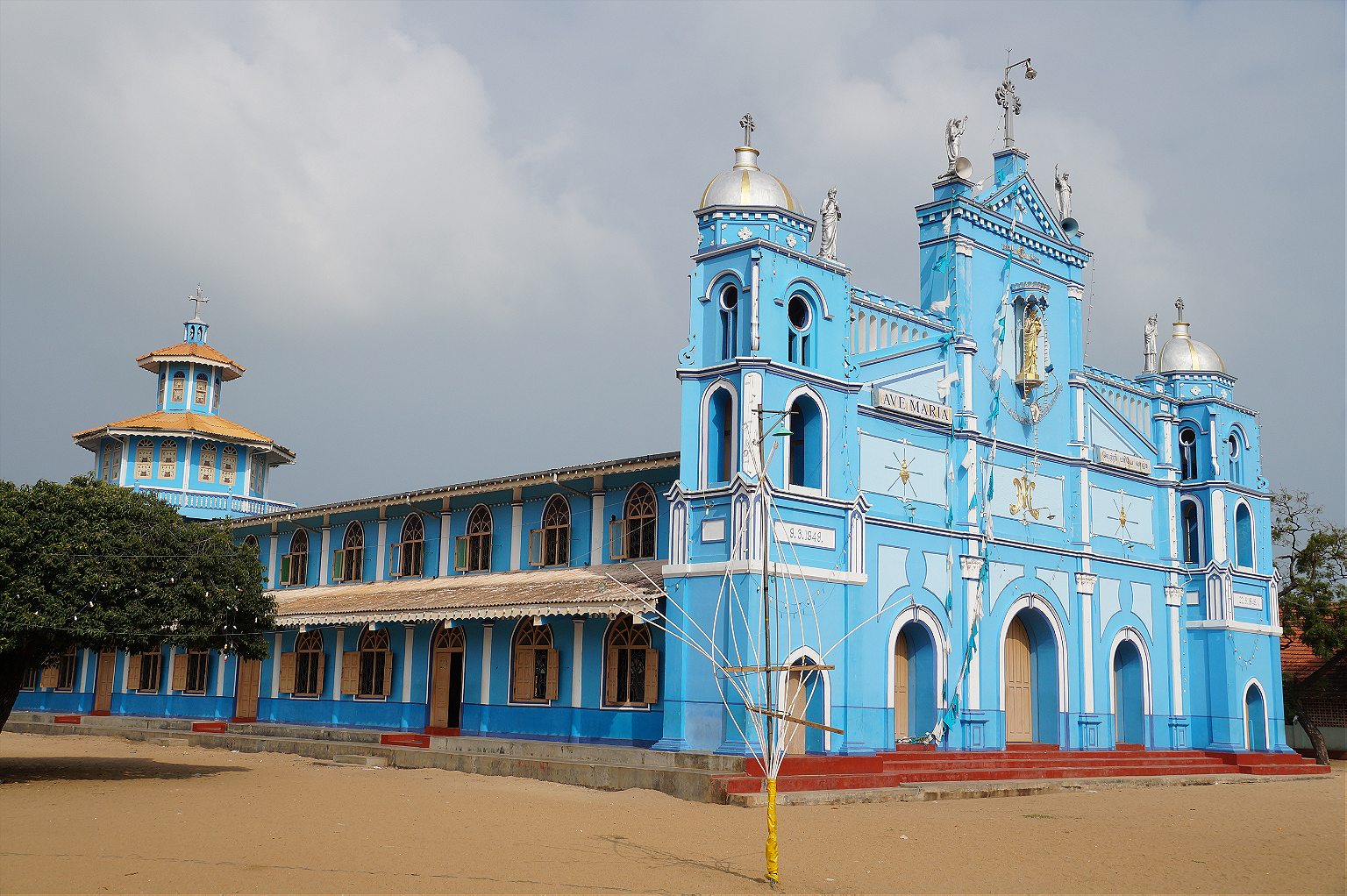
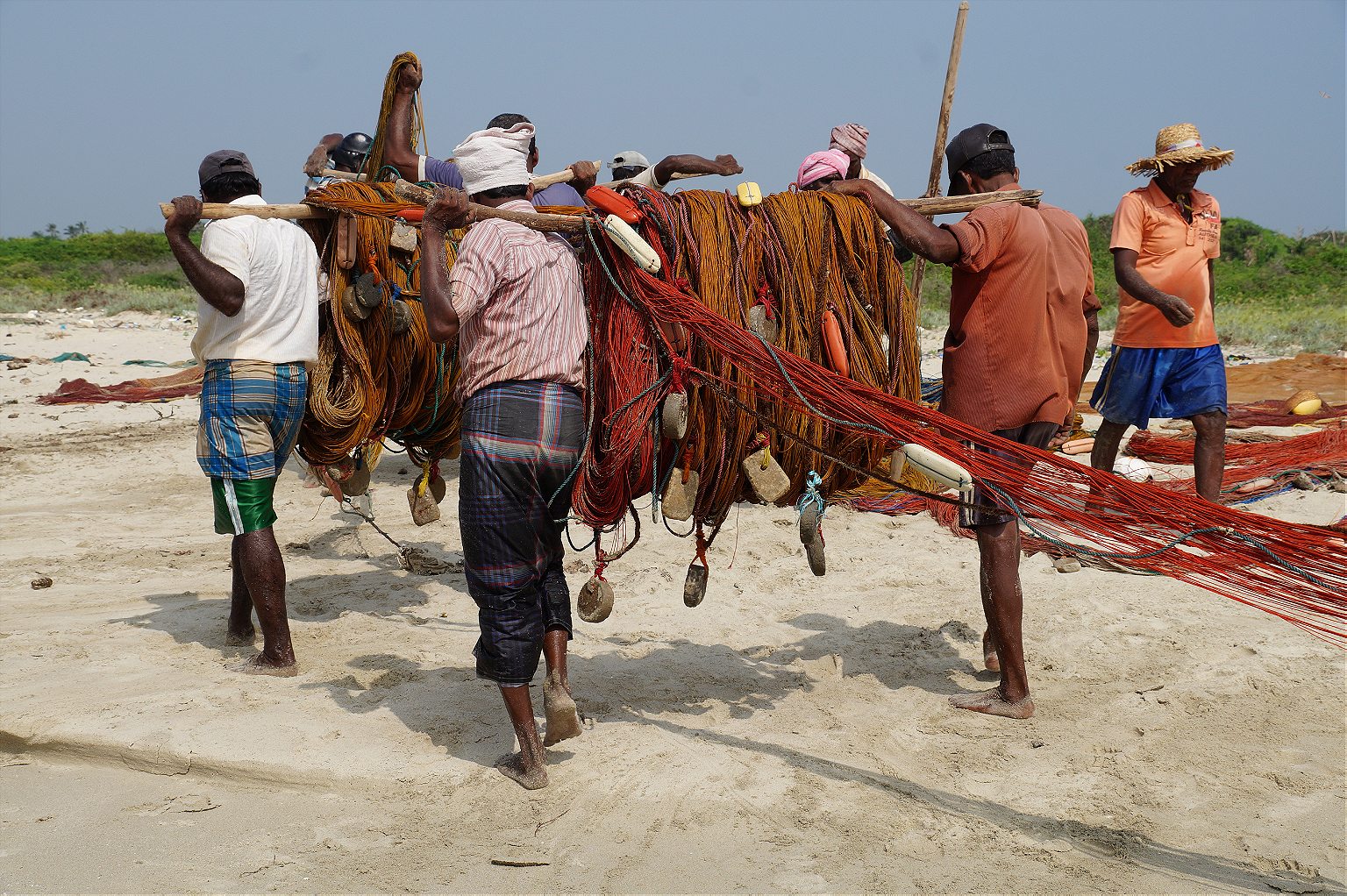
Stephen Croos is one of the most prosperous fishermen in the Sri Lankan village of Pesalai, Mannar Island’s most productive harbor. Now 50, he’s fished these waters since he was 8 years old. “When I was a boy,” he remembers “there were only 500 families and we made small incomes from karavalai,” a traditional, labor-intensive fishing method that involves dragging a great length of net in a giant parabola from the coast and hauling it onto the beach by hand. “Then the population started growing, the equipment got better, the catch got better. If not for the war, development would have come 30 years ago.”
Like most people in Mannar, Croos fled his home for the first time in 1985, two years after the war broke out, leaving Pesalai by night to sail with his family for Rameswaram. Indian fishermen, then still friendly with their fellow Tamils, met them on the beach with steaming cups of tea and coffee before ushering them onto buses headed inland to state-run refugee camps. Croos left his small fiberglass boat, his sole source of income, on the beach. He never saw it again. He returned home in 1987, only to flee for a second time three years later. Once again, he lost everything.
Croos seems imperturbable, his body and mind preternaturally steady after decades spent on rough seas. He’s managed twice now to rebuild his life from scratch. “We’re blessed here with very good seas,” he said. “Even if you have to start again with nothing, if you’re industrious, you can return to your life in a year.”
But if Indian trawlers continue to cross the border into sovereign Sri Lankan territory, Croos fears for the future of the seas that have repeatedly saved him from destitution. “If the invading trawlers continue to come then we may not be able to fish anymore,” he told me. “Little by little we’ll become paupers.”

For the fishermen who still rely on traditional methods, that prediction may soon become a reality. Some days after arriving in Pesalai, I met a fisherwoman called Annamah, who’s spent the past 20 years helping her son pick fish from his nylon nets. “Already there are 15 or 20 varieties of fish that no longer come,” she told me. A sinewy older man called Raja, helping with the day’s work, interjected with a scoff. “After five years there will be nothing left in the sea,” he said. Annamah laughed but didn’t dispute his claim.
I stood with Croos on my first morning in Pesalai, facing water crested with waves blown in by the last ragged breaths of the northeast monsoon. Fiberglass boats crowded the beach. Gulls and crows and egrets swarmed around the discarded remains of small silver fish, the tented skeletons of box fish, and the limp lobes of puffers opened and eviscerated for their meaty loins. A hundred small trawlers—one of them Croos’—bobbed on the horizon.

At 7 a.m. on the day before Christmas, the Indian village of Rameswaram’s fish-slicked concrete jetty was crowded with trawlers recently returned from the sea. Hundreds of worn and beaten boats, their decks silvered with huge quantities of fish, crowded the harbor. Plastic baskets stood in stacks and rows, each filled to the brim with oil sardines, which constituted the bulk of that day’s catch. Across the harbor, the yellow tower of the Rameswaram temple stood in sunny relief against a bright winter sky.
Of the 2,500 trawlers that operate out of fisheries on the Indian side of the strait, as many as 1,300 of them dock in Rameswaram (exact numbers are tough to come by). Mechanized boats can legally go to sea three days each week—the other four are reserved for smaller “country boats”—and on a given day at least 650 leave Rameswaram’s harbor. Boats typically return with a pull of five to 15 metric tons of fish, much of it from the Sri Lankan side of the border. Most of the catch will go to processing plants where it becomes chicken feed. Some will go to market, but much of it, caught prematurely by indiscriminate trawling and too small for human consumption, will simply be tossed out. On a catch like that, the senior-most laborer on board can earn as much as 20,000 rupees—a little less than $300—not bad for a night’s work.
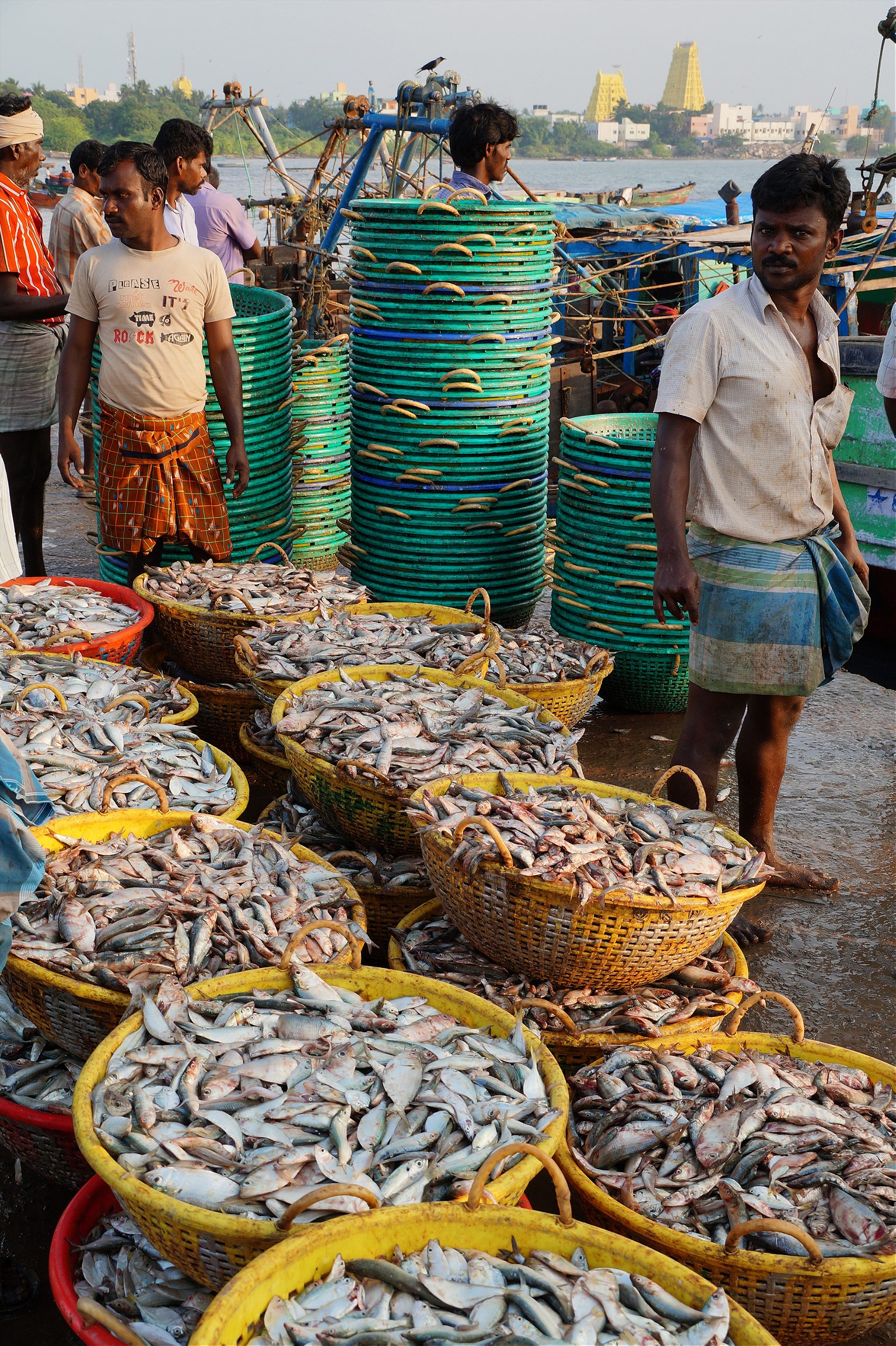
In just a few hours at the jetty, I met five different fishermen who’d had run-ins with the Sri Lankan navy the night before. One told me with a rueful laugh that the navy guys had thrown rocks and bottles at his boat. Another, whose boat had returned that day with 15 metric tons of fish, told me he’d seen navy boats cut nets off three other trawlers. His boat, he said with swashbuckling bravado, had escaped.
Two fishermen named David and Michael, who’d gone out in their small wooden launch, said a group of young naval officers had boarded their boat and proceeded to throw their ice, rice, fuel, and 300 kilos of freshly caught fish into the water. Michael showed me bruises on his legs where they’d hit them with batons. “They said, ‘Don’t come back here. Stay in India,’ ” David told me. “I think they were drinking.”
Another fisherman, named Don, approached anxiously, desperate to join the conversation. “These people from the navy are animals,” he said. “If the Indian government gave us guns, we’d go fight them ourselves.”
A few miles west of the harbor, I visited a small, breeze-washed home that Fernando’s murdered crewmate John Paul had built with his wife, Janitta. The palms along the nearby church were strung with paper stars and fairy lights. Inside, a small floor fan blew briny air across the room.
Since her husband’s death, Janitta’s only source of income has been the monthly government stipend of 2,750 rupees—about $40—given to the wives of Indian fishermen killed by Sri Lankan forces. That’s less than her husband would have made on even the worst day at sea. “Before we had some luxury,” she said, quiet and stoic with dark, sharp eyes. “We would have mutton and chicken and fish a few times each week. Now it’s only on festivals—if we’re lucky.”
I asked if she’d tried to stop her husband from going to sea that day. “We knew it was dangerous, but we needed it for our earnings,” she said with a shrug. “I didn’t know that day was different from any other day.”
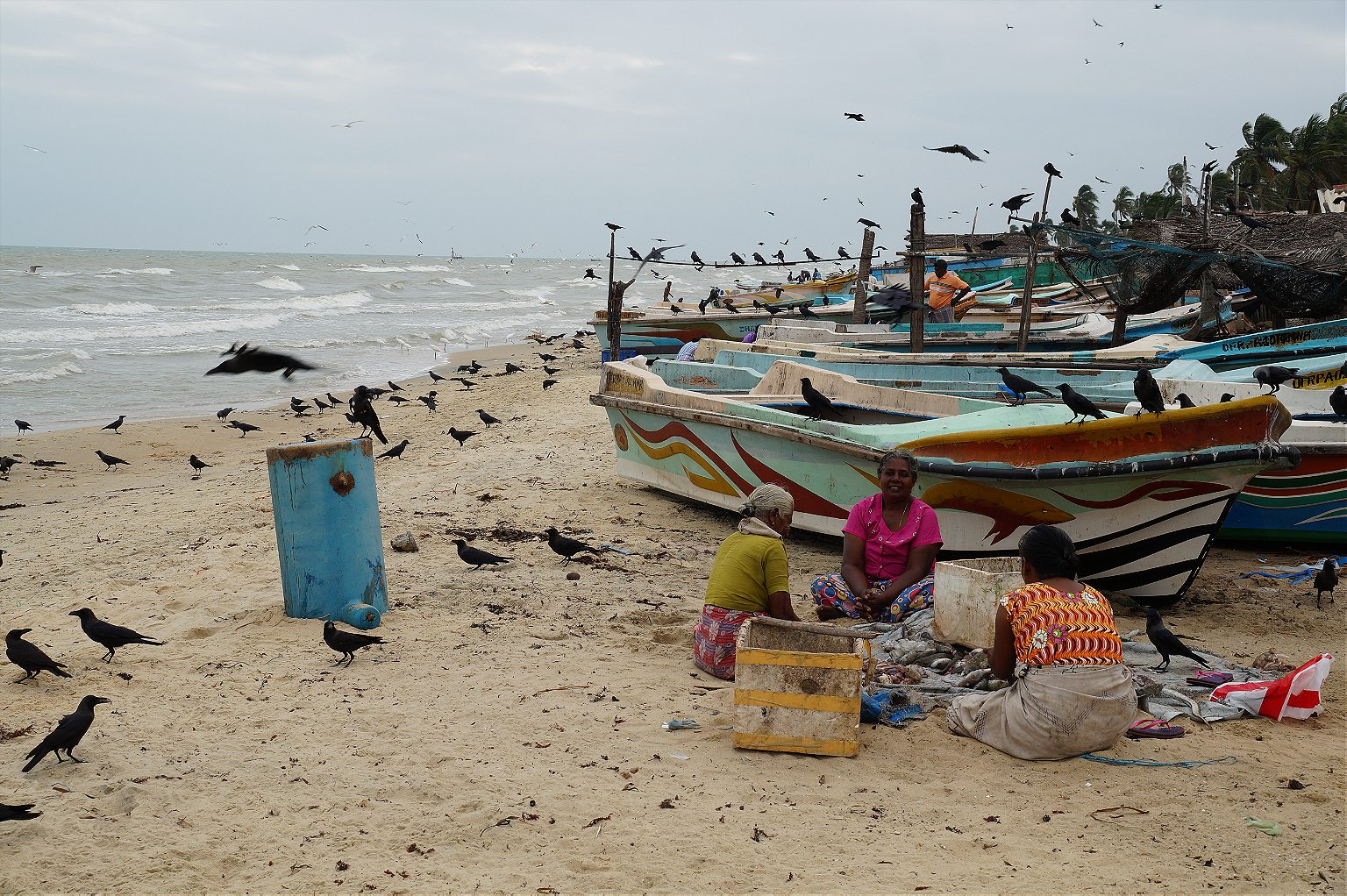
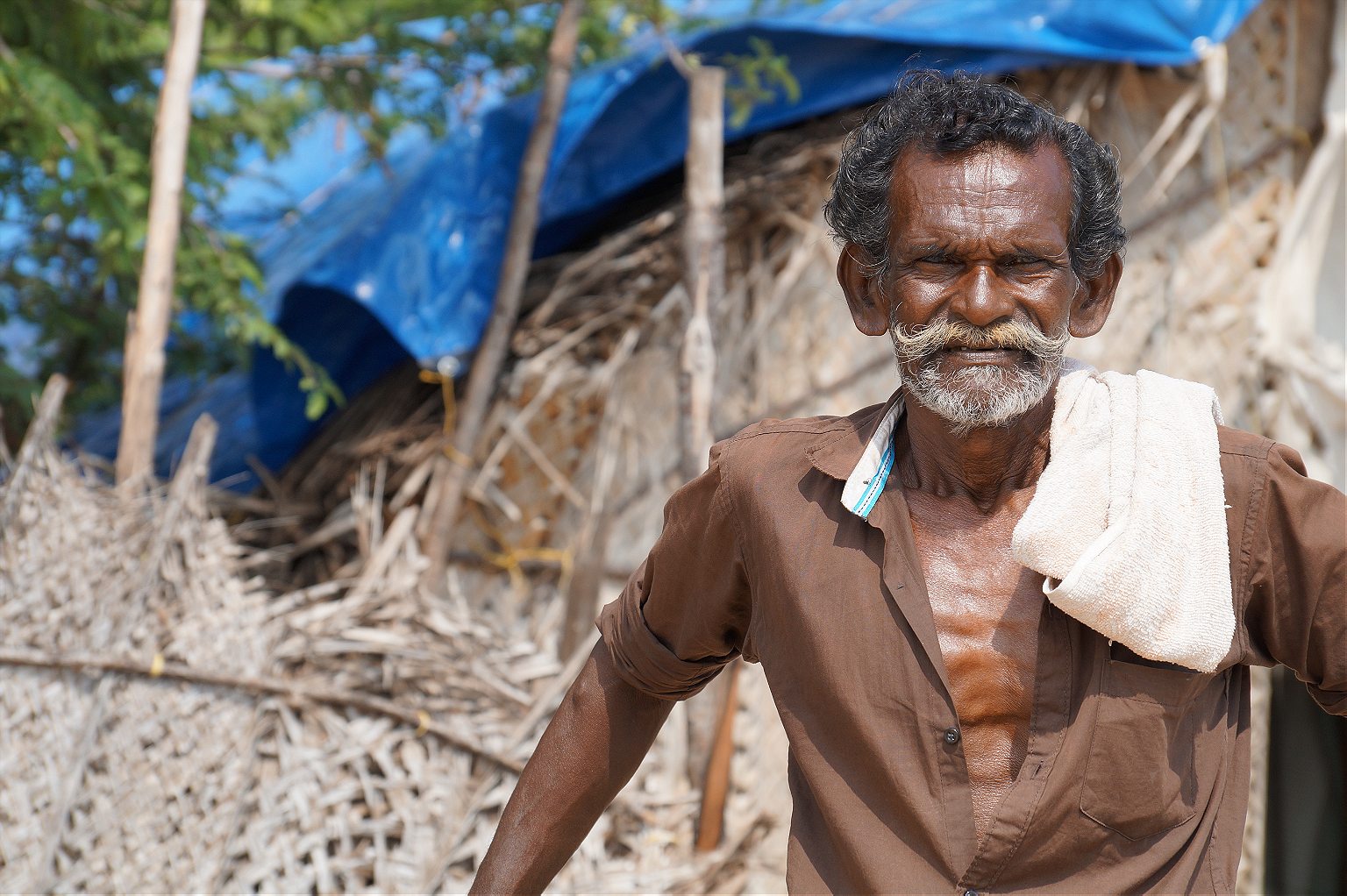
Where Rameswaram has a broad concrete jetty projecting into the sea, Sri Lanka’s Pesalai only has a narrow stretch of sand fringed with palms and brown-bearded palmyras. Above their shaggy green heads rises the high spire of the town’s church, built a few years back using tithes. Only those who belong to the parish can keep their boats on Pesalai’s beach, divided, like the rest of the island’s shoreline, into 600-meter-long units of community-owned property known as pardu. The local Tamil dialect uses that word, pardu, for “work” and “the day’s catch.” It also means “struggle.”
Croos has weathered his own struggles with remarkable fortitude and grace. He married his wife, Mariyarani, in 1990 at a refugee camp outside the landlocked Indian town of Dindigul, 90 miles from the nearest coast. They’d had a simple ceremony and a modest lunch of chicken curry and biryani; fishing families don’t usually eat seafood on special occasions. Two years and two kids later, Croos and Mariyarani decided to return to Pesalai. “There weren’t many people left. It was silent,” she remembers. “We started to build our lives back up again.”
Croos got a job as a day laborer on a small boat and started saving. Within a few years, he had enough to buy a small fiberglass boat secondhand—his third. By 2004, he’d saved enough to buy a trawler. Croos continued putting money away and in 2010, on their 20th anniversary, he and Mariyarani decided the time had come to build a new home. They’d since had a third child and wanted a larger, more solid house.
Last October, they moved in. The place is big, hidden behind tall metal gates, its two stories of concrete painted a lurid shade of turquoise, festooned with golden balconies and mauve trim. Heavy wooden doors lead from the deep front veranda into the pink living room, a pair of giant prawns carved in low relief on their burled surface: the house that fish built.
During the five days I spent as a guest in the Croos’ house, Mariyarani cooked as though the sea would never stop giving. For my first lunch, she prepared a curry of dry fish stewed in coconut milk, spiced with red chili, coriander, cumin, black pepper, and fennel; the same flavors I’d tasted in Rameswaram.
The next day, she used the same spice mix to prepare a curry of crab and cuttlefish scented with astringent curry leaf and soured with tamarind. Crab and cuttlefish and prawns turn up on the Croos’ table every couple of weeks, Mariyarani told me; they can take their pick of the catch whenever they like.

Stephen Croos makes a good living with his trawler, using it to fish with both simple drag nets (which are legal) and sometimes for illegal bottom trawling, the same kind used by Indian fishermen, though on a far more modest scale. But though fishermen like Croos have profited from these new technologies, they also know the good times won’t last indefinitely. Mannar’s fishermen are outnumbered and outpowered by the thousands of larger, stronger boats that cross over from India each week. Even on the best day and using illegal methods, Croos won’t bring in anything like the kind of catches that I’d seen in Rameswaram. In 2014, their best year since the war started, Pesalai’s fishermen netted 15,400 kilos of fish—the same amount that an Indian trawler can pull in on a single day.
Since the war ended, Pesalai’s annual catch has rebounded far faster than those of other villages on the island, where illegal trawling is less common. When I asked B.S Miranda, the assistant director of Fisheries for Mannar District, about local use of trawlers, he said, “It was recommended that we stop bottom trawling so first we have to stop the Indian trawlers,” as though the latter were a necessary precondition for the former.
No one in Mannar mentioned the use of trawling by local Sri Lankan fishermen when explaining the shortages they will face in the none-too-distant future. No one mentioned rising water temperatures, which, combined with sediment kicked up by bottom trawling, have already caused extensive coral bleaching in the strait. As of May, bleaching levels in the waters surrounding Mannar Island had reached as high as 33 percent, and while coral ecosystems can recover from bleaching events, continuing rises in water temperatures and ongoing use of illegal bottom trawling could permanently destroy the coral shoals that make the strait such a productive breeding ground. No one mentioned the plans, approved two years ago by the Indian government, to dredge a shipping canal through the shallows of the strait, or the Sri Lankan government’s attempts to attract international oil companies to dig for oil and natural gas in the Mannar basin, off the island’s southern coast. For now, Indian fishermen, with their larger trawlers and predatory tactics, make a more convenient—and perhaps a more manageable—scapegoat.
Early on my last morning in Pesalai, Croos sent me with his cousin, Sebastian, to try my hand at karavalai, the old style of fishing now practiced regularly by maybe a dozen groups. At the beach, I boarded a small motorboat with Sebastian and two others from his crew. As we sailed out from the shore, we dropped a series of weighted nets, tied one to the other and connected at either end to tractors parked back on the beach. It took three hours for the gears mounted on the tractors to draw the nets back in while Sebastian’s 14-man crew stood idly by, pointing absently at the gulls plunging toward the water.
When the net neared the shore, Sebastian waded into the surf and genuflected toward the sea. Together the men dragged the net the remaining few meters onto the beach, leaving a spangled trail of scales across the sand.
Using the only Tamil phrase I knew, I asked Sebastian: “Meen pardu ebaddi?” How’s the catch? How’s the struggle?
Sebastian eyed the net with a vague, resigned smile: “Not so good.”
